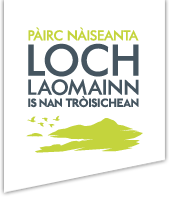
The language of the landscape
What’s in a name?
Loch Lomond & The Trossachs is at the southern edge of the Gàidhealtachd (or ‘Highlands’), the largely mountainous part of Scotland in which Gaelic was the dominant tongue following its retreat from the Lowland regions of the south and east.
The name Loch Lomond was earlier Loch Leamhain (loch LEFin), named after the River Leven ‘elm water’; the region is known in Gaelic as Leamhnachd (LEH-oon-uchk, anglicised Lennox), also from the river name. However, the loch is overshadowed by Beinn Laomainn (bayn LOEUmin) ‘beacon mountain’, presumably a site for beacon fires in ancient times, and the mountain’s name was ultimately adopted for the loch itself. Beinn Laomainn and Loch Laomainn became Ben Lomond and Loch Lomond in English.
The Trossachs is an anglicisation of Gaelic Na Tròisichean (nuh TRÒSHeechun) ‘the places lying athwart’. The name strictly applies to the hills dividing Loch Katrine from Loch Achray, which lie at a right angle to the glens containing the lochs. Its root is thought be trōs, a Brittonic word represented in modern Welsh by traws (a Gaelic word with the same root is tarsainn, found in the park in Beinn Tharsainn – ‘the crosswise mountain’). The word order in Gaelic place names tends to be the opposite of English, with the noun followed by the descriptor or adjective. Thus, Loch Lomond & The Trossachs National Park is rendered in Gaelic as Pàirc Nàiseanta Loch Laomainn is nan Tròisichean (park NAASHuntuh loch LOEUmin is nun TRÒSHeechun).
The Gaelic language
For hundreds of years, up until the 19th Century, Gaelic was the language of most of the inhabitants of the Park area. We are told, for example, that in around 1724, Gaelic was the sole language in Balquhidder, Callander, Aberfoyle, Luss and Arrochar, and the majority tongue in Buchanan and Port of Menteith. As late as the 1950s, native Gaelic speakers were still to be found in places like Balquhidder, Brig O’ Turk and Killin.
Gaelic has a rich vocabulary for describing landscape. For example it has over 80 words for hill, mountain or slope. Some words like bog, caol, càrn, coire, creag, gleann, linne, loch, machair and srath are familiar to English speakers as they have been adopted into that language as bog, kyle, cairn, corrie, crag/craig, glen, linn, loch, machair and strath (although, with the exception of loch and machair, the pronunciation of the borrowing is different from the original). The table below list some names of landscape features common in the National Park.
Gaelic Pronunciation Translation
allt (OWLT) burn, stream
bealach (BYALuch) pass, route
beinn (BAYN) mountain
cnoc (KROCHK) hill
coire (KORuh) corrie
creag (KRAYK) crag, rock
druim (DROOim) ridge
gleann (GLEH-own) glen, valley
maol (MOEUL) bare hill, mountain
meall (MYOWL) lump-shaped hill, mountain
sìthean, sìdhean (SHEEhun) knoll (often associated with the sìthichean or fairies)
sròn (STRÒN) nose, end of mountain ridge
stob (STOP) peak, summit, something sticking up like a post
tom (TOWM) hillock
A pronunciation guide
The alphabet is identical to that of English (based on Latin), except that it has only 18 letters (j, k, q, v, w, x, y and z not being present). The accents on Gaelic vowels indicate an elongation of the vowel and are important for pronunciation. An approximate pronunciation guide is given (based on Scottish accented English) but it must be noted that the sounds of Gaelic are impossible to reproduce accurately with such a tool.
Capital letters indicate where the emphasis lies. Here are some more pronunciation tips.
Vowels
AA: long ‘a’
AY: as in ‘day’
OA: as in ‘soar’
EY: as in ‘eye’
Ò: long ‘o’, as in ‘cord’
OEU: close to French ‘oeuf’
OO: as in ‘soon’
OW: as in ‘now’
OY: as in ‘boy’
Consonants
CH: as in loch
S: like ‘ss’ in English,
never a ‘z’
TCH: like ‘ch’ in church

